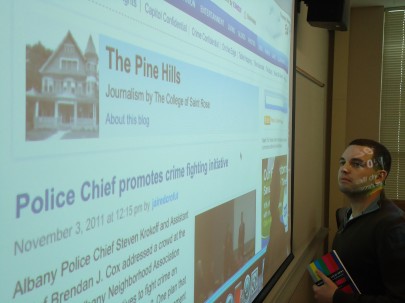By KAYLA MATTEO, SCOTT LAWSON, CHAD GAMBOA, and TOM MCDONALD
Newsroom
PUBLISHED NOVEMBER 15, 2011
A neighborhood meeting intended to collect input about the Pine Hills blog and to encourage feedback will take place Thursday, Nov. 17, at the Pine Hills library on Western Avenue at 6 p.m.
Journalism students at The College of Saint Rose hope to hear from Pine Hills residents about how they might improve the student-produced content hosted at timesunion.com.
The Pine Hills blog began in the Spring of 2010. All of the content on the blog is researched and written by journalism students at Saint Rose in the Pine Hills neighborhood.
This project is just one of many unconventional collaborations between mainstream and legacy media organizations across the country aimed at reaching audiences with more local content. Saint Rose’s partnership with the Times Union mirrors a number of similar arrangements between newsrooms and classrooms.
“I think it’s great on many levels,” said Leah Golby, a member of the Albany Common Council who represents the Pine Hills neighborhood. “It connects the journalism students to the community in a way it didn’t before.”
Because Saint Rose is located in the center of the Pine Hills, she sees it as an intricate part of the neighborhood. However, sometimes that is forgotten. The Pine Hills blog works to piece

together what might have otherwise been two entirely separate entities, the college community and the local community. “Sometimes we don’t realize that we are all part of the same neighborhood,” Golby said.
She said the blog stories are informative in ways that surprised her. She cited an article published on May 25 about Nancy Thorsen, a cashier at the Madison Avenue Price Chopper. The ability to learn more about someone she sees frequently when buying her groceries was really great for Golby. She finds that the Pine Hills blog shares important stories with the neighborhood and the city that might not have otherwise been told.
Saint Rose students are not the only students reporting hyperlocal news.
At the University of Massachusetts at Amherst students have reported on many different issues lead by professor Stephen J. Fox, who has been teaching a class on this form of reporting for about three years now. In the past, his students have reported stories about a teen suicide and tornadoes in the town of Monson.
“Students covered meetings, and were the often the only reporters there most of the time,” Fox said. His students are generating neighborhood coverage for both print and online outlets. Like students at Saint Rose, UMass Amherst students’ work finds a larger audience, in their case through a blog affiliated with the Boston Globe.
Students there received positive feedback for their reporting, especially from the residents of Monson.
Neighborhood reporting by students is also happening across the country at Stanford University’s Peninsula Press. The Peninsula Press, a blog hosted by the San Francisco Chronicle, covers two counties in the Bay Area accounting for about three million residents. Started around the same time as the Pine Hills blog, in April of 2010, the Peninsula Press is run by graduate students under editor Kathryn Roethel.
Roethel said partnerships with established media outlets like the San Francisco Chronicle and a recent collaboration with KQED, an NPR affiliate, have helped the project succeed. Non-exclusive partnerships make it possible for them to partner with as many media presences as they want.
While the Peninsula Press has a large community following, they cover such a large area that they don’t feel as close with their audience as they could. Covering two counties put some of their readers as far as an hour away from Stanford. However, using programs like Cover it Live, they are able to create a sense of community on their site by allowing their readers to participate in live coverage of events, such as election day. On Tuesday, they used Twitter to provide live coverage of local elections. Some 400 community members became involved in the coverage of this week’s elections using the Cover it Live feed.
In Seattle, a hyperlocal journalism site, CrossCut.com, hosts community meetings to encourage involvement. “We partner with a city council member and send out daily e-mail newsletters to get the word out,” said Berit Anderson, an editor at CrossCut.
This semester, Journalism II students at Saint Rose conducted an accuracy check of content on The Pine Hills blog. The goal was to measure the accuracy of student reported stories. Students mailed letters to 18 random sources from 159 stories published on the blog. Recipients received a short survey with a self-addressed stamped envelope.
As of November 11, some 67% of the surveys were completed and returned. Only one inaccuracy, a misspelled name, was reported by a source, after which, a correction was posted. Another source indicated that pertinent information was omitted from a story. That information was later added.
In addition, one-third of respondents indicated they were satisfied with the reporting by student journalists. Ninety-two percent of respondents said they would welcome another interview.
The student model for hyperlocal journalism, though, is not without faults.
Semester-by-semester reporting makes continuity difficult, according to Jan Schaffer, executive director of Washington-based J-Lab: The Institute for Interactive Journalism. Schaffer criticized student reporting because student coverage comes and goes based on the academic calendar, including semester breaks and vacations.
The upcoming community meeting sponsored by The Pine Hills blog Thursday at 6 p.m. at the Pine Hills library is free and open to the public.

